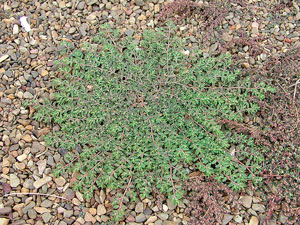Resource Library
Plant of the Week: Spurge, Prostrate
The University of Arkansas System Division of Agriculture does not promote, support or recommend plants featured in "Plant of the Week." Please consult your local Extension office for plants suitable for your region.
Plant of the Week
Prostrate Spurge
Latin: Chamaesyce maculata

This common garden weed is found in every state of the Union and in many foreign countries (Photo courtesy Gerald Klingaman)
As gardeners, we make judgment calls all the time. One of the most common is “good plant, bad plant” with the bad plants usually dismissed as weeds. Weeds are tough plants that are habitat generalists capable of growing in a wide array of difficult sites. And they grow fast, often outperforming the plants we are attempting to grow. Prostrate spurge or sandmat (Chamaesyce maculata) – a.k.a. Euphorbia maculata - though not really a serious competitive weed to most garden plants because it grows flat on the ground, is a weed nonetheless.
Prostrate spurge is a mat forming annual herb of the euphorbia family that is native to all of the contiguous United States, most Canadian provinces and much of Mexico. It forms a high mat usually an inch or two tall with a cluster of slender, much-branched stems originating from a single, also slender deep growing taproot. Its leaves are elliptical, paired along the stem and usually about one third of an inch long. Leaves may be green, gray green or maroon and are often marked with a maroon blotch. The stems and leaves exude white latex when cut.
The white flowers are tiny four-petaled affairs borne along the stem that require young eyes or a hand lens to really see. The fruit is a small, but the typical plump three-locualar capsule of the euphorbia family. And like all good weeds, prostrate spurge produces a lot of seed that is capable of surviving a number of years in the seed bank of the soil.
The Latin name Chamaesyce translates as “low growing on the ground” and is an apt name for the spurges in general and this species in particular. It is an old name used in Gerard’s 1633 edition of The Herbal. Botanists have traditionally combined all white latex producing plants into the large Euphorbia genus but in recent years the trend has been to separate the spurges out into their own group.
Mankind’s arbitrary designation of plants into categories such as weeds, wildflowers, forbs or herbs is but the simplest form of classification. The word weed is from Old English, dates to the 7th century, and is derived from “weod.” In the beginning the word referred to all plants – including grasses – that grew together in a meadow. By the Middle Ages it had taken on its current meaning – a plant whose virtues have not yet been discovered – according to Ralph Waldo Emerson. By about 1600 the word morphed into slang to describe tobacco as it did again in the 1920s to describe marijuana.
It is unlikely prostrate spurge will ever be anything but a weed. As weeds go, prostrate spurge is more of an annoyance than a real threat to crops. It prefers sunny, hot sites and open sandy or loose ground so it seldom overpowers other plants. It does not grow in the shade. Because of its deep taproot, it is not an aggressive competitor for water and nutrients used by the plants we are growing. But, it is there growing where it is not wanted, so it is an annoyance.
Hand weeding is the most practical solution for established plants, and thanks to the deep but easily pulled taproot, is easily accomplished. Mulching in early spring excludes light and prevents seed germination.
A wide array of pre-emergence herbicides will control it but they must be applied before seeds germinate in mid-spring as the soil temperatures warm. These are seldom used in the real world against this specific weed but may provide some control if the compounds are used against more aggressive weeds. Post-emergent herbicides such as glyphosate will also kill it, but applications should be made early in the season when plants are small and before seeds form.
By: Gerald Klingaman, retired
Retired Extension Horticulturist - Ornamentals
Extension News - July 22, 2011
The University of Arkansas System Division of Agriculture does not maintain lists of retail outlets where these plants can be purchased. Please check your local nursery or other retail outlets to ask about the availability of these plants for your growing area.